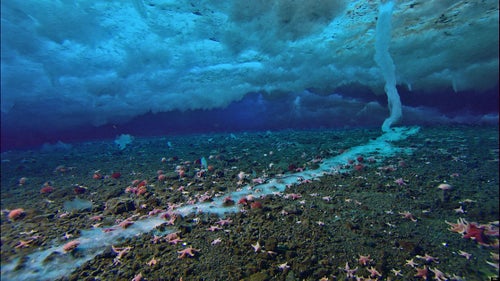Fans of the BBC's Frozen Planet were treated to the first ever footage of a brinicle, a deadly finger of ice that kills everything in its path.
Starfish and sea-urchins shrivel up and die, encased in a “tomb of ice” as the frozen tornado whirls its destructive path to the sea floor.
The extremely salty 'brinicle' is not quite a solid icicle. The sea water is only forming a frozen 'sheath' around the cold saline, rather than freezing all the way through. Dr Mark Brandon, a polar oceanographer, described it as "a seawater-soaked sponge with a tiny network of brine channels within it."


The salt-water icicle forms in calm seas when the freezing air above the surface is much colder than the sea. They first appear at the frozen surface of the sea. They used to be called ice stalactites until 1974, until a new theory was advanced as to how they are created.
David Attenborough's erudite tones described the formation of the brine beam: "The salt in this newly formed ice is concentrated and pushed into the brine channels. And because it is very cold and salty, it is denser than the water beneath."
Filmed in frigid Antarctic waters at temperatures of minus two degrees celsius, cameramen Hugh Miller and Doug Anderson dived underwater at Little Razorback Island, near Antarctica's Ross Archipelago.
Time-lapse filming equipment was set up, but navigating the icy ocean floor amid sea proved difficult. Inquisitive seals pushed the camera about.
"That particular patch was difficult to get to. It was a long way from the hole and it was quite narrow at times between the sea bed and the ice," explained Miller.
"I do remember it being a struggle... All the kit is very heavy because it has to sit on the sea bed and not move for long periods of time.
"The first time I did a timelapse at the spot a seal knocked it over," said Mr Miller.
Cameramen expressed shock at how quickly the almost fantastical brinicle formed, telling the BBC
"It was a bit of a race against time because no-one really knew how fast they formed," said Miller.
"The one we'd seen a week before was getting longer in front of our eyes... the whole thing only took five, six hours."